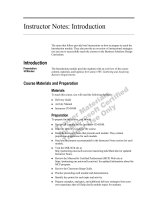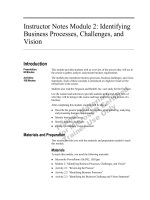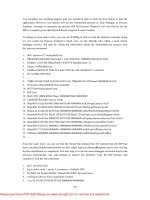Tài liệu Instructor Notes Module 8: Solution - Design and the Component Object doc
Bạn đang xem bản rút gọn của tài liệu. Xem và tải ngay bản đầy đủ của tài liệu tại đây (89.47 KB, 4 trang )
Instructor Notes Module 8: Solution
Design and the Component Object
Model
Introduction
This module provides students with a brief foundational understanding of the
Microsoft
®
Component Object Model (COM) and associated technologies. This
understanding is necessary to make good decisions about candidate
technologies. Microsoft’s Component Object Model, Distributed Component
Object Model (DCOM), and COM+ each provide services and structure that aid
in implementing large applications. These models provide many benefits that
can be used by the application designer and developer. This module describes
these technologies and presents guidelines for implementing them.
After completing this module, students will be able to:
!
Describe the Microsoft COM standard.
!
Describe COM classes, components, objects, and interfaces.
!
Explain the relationship between COM and application development.
!
Describe DCOM and its relationship to COM.
!
List the benefits of using COM in a solution design.
Materials and Preparation
This section provides you with the materials and preparation needed to teach
this module.
Materials
To teach this module, you need the following materials:
!
Microsoft PowerPoint
®
file P08_1608a.ppt
!
Module 8, “Solution Design and the Component Object Model”
!
Activity 8.1, “Simulating Component Communication”
!
Instructor handout for Activity 8.1, "Simulating Component
Communication"
!
Activity 8.2, “Identify the Impact of Distributing COM Components”
Presentation:
55 Minutes
Activity:
35 Minutes
2 Instructor Notes Module 8: Solution Design and the Component Object Model
Preparation
To prepare for this module, you should:
!
Read all the materials for this module.
!
Complete the activities.
!
Familiarize yourself with Microsoft’s Component Object Model (COM)
!
Familiarize yourself Microsoft’s Distributed Component Object Model
(DCOM)
!
Familiarize yourself with Microsoft’s COM+, the evolution of COM.
Instructor Notes Module 8: Solution Design and the Component Object Model 3
Activities
Activity 8.1: Simulating Component Communication
In this activity, you will simulate the communication between components.
This activity will illustrate how COM has simplified component
communication.
After completing this activity, students will be able to:
!
Demonstrate how COM technologies enable component-based solutions to
work.
!
To prepare for the activity
1. Prepare the message papers in a quantity adequate for your class.
2. Work through the activity yourself to be sure that you understand the
various messages and interfaces.
3. Prepare some questions to foster a class discussion.
Activity 8.2: Identifying the Impact of Distributing COM
Components
In this activity, students will identify potential problems in a distributed
component topology.
After completing this activity, students will be able to:
!
Identify issues with distributing COM components over a network topology.
!
To prepare for the activity
1. Complete the activity.
Think of alternate problems that students may perceive.
2. Prepare some questions to foster a class discussion.
4 Instructor Notes Module 8: Solution Design and the Component Object Model
Module Strategy
Use the following strategy to present this module:
!
Component Object Model Basics
In this section, students learn about the COM standard, which is the
foundation for application design based on Microsoft technologies.
Therefore, this section is pivotal to your students’ success as developers.
You will probably have some students who are familiar with COM, as well
as others who are completely unfamiliar with the COM standard. Gauge the
time you give to this section on the understanding of your class. You cannot
afford to leave anyone behind because this section is foundational to the
sections that follow.
!
Activity 8.1: Simulating Component Communication
This is a somewhat different activity than the others in this course. In this
activity, students role-play components that are attempting to communicate.
Although this might be a fun activity, it also illustrates how COM simplifies
component communication.
Be prepared to discuss the component interfaces after the activity is
completed.
!
Application Development and COM
This section begins to delve into the issues involved in developing with
COM. It contains a great deal of information, so you may have to slow your
presentation pace to allow students to absorb the concepts.
Have examples ready to aid students’ understanding of the concepts, but be
careful not to get bogged down. Students will completely understand the
concepts only after they have put them into practice later in the course.
!
Distributed Component Object Model Basics
In this section, students learn about DCOM and its ability to allow COM
components to reside on different machines and to be executed remotely.
Most students will immediately grasp the advantages of such a technology;
be sure to help them to understand the potential problems as well.
!
Activity 8.2: Identifying the Impact of Distributing COM Components
This activity will provide students with an opportunity to explore some of
the issues of distributing COM components. Have some questions ready for
a class discussion.
!
COM-Based Designs
This section provides an overview of the benefits of COM and DCOM, as
well as an introduction to the improvements in COM+. The advantages of
using COM to modularize application development and encourage code
reuse should be obvious to your students by the end of this section.









